
The organic forms and colors of Cecile Hirschler Alberti’s artworks are scenes suspended in growth and conflict. Alberti, born in New York City, and now living and working in New York City, is driven by her love of nature, contemporary mythologies, and the cyclic change of life and death in order to create environments that are representational of the heavenly and demonic.
Using a large palette of colors, Alberti creates otherworldly scenarios that are both gleaming and gloomy, offering new worlds of hope and possibility as well as disaster and chaos.
The forms used in Alberti’s work are taken from her everyday life and textbook research, along with her deep appreciation of fantasy archetypes from popular culture. Fantasy works such as Dungeons & Dragons, The Chronicles of Narnia, The Hobbit, Swan Lake, and tarot cards are all points of interest for Alberti and can be seen within her vibrant scenes as she investigates themes of catastrophe, ecology, alienation and intimacy, popular fantasy, and non-human agency.
Alberti graduated from the Rhode Island School of Design with a BFA in printmaking and received her MFA in studio art from New York University, Steinhardt. Her work has been shown at Hong Kong City Hall; Palo Gallery, Hong Kong; DDDD Pictures, New York; O’Flaherty’s, New York; Monumental Callao, Peru.
Phillip Edward Spradley: Can you discuss your beliefs and how you see these reflected within your artwork?
Cecile Hirschler Alberti: Faith and religion are distinct. Faith, to me, is about identifying and practicing a set of values, reflective of cultural upbringing, which are then reified as religions and communal systems of belief.
I was raised Roman Catholic, and the iconography and the parables it represents became an important source material. From the stories in the Old and New Testaments, to household iconography, to Church altars, symbolism and narrative arcs accompany you persistently.
My father is an atheist Jewish man who was upfront about not believing in a “God” to me even as a child- but highlighting he would still come with us to Church because it was an agreement he had made with our mother given her belief in the moral associations of Catholicism (and with age, her hope for the existence of “Heaven”).
It seemed natural to me to explore the reasoning behind different labels early on. The subjectivity of interpretation between these ideas of faith and religion, personal and collective narrative, informs the multiplicity in symbolism and the range of source material I use in my work.
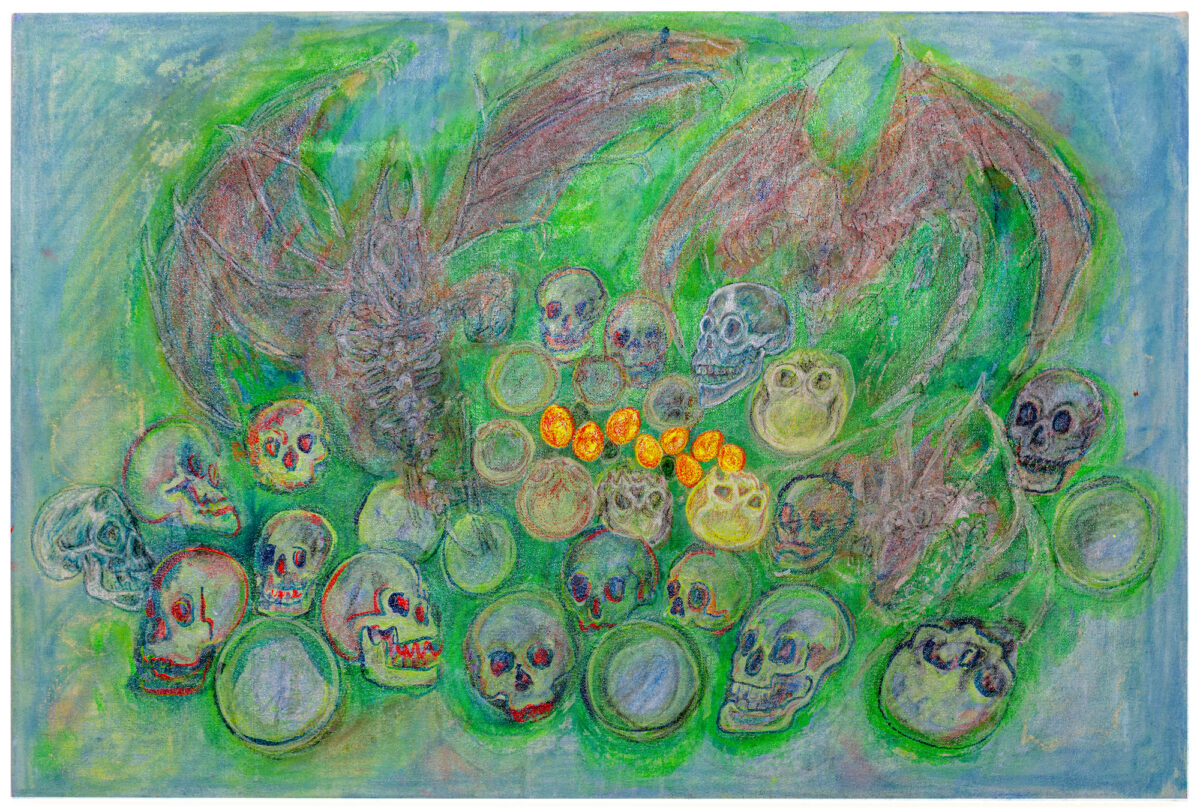
P.E.S.: You’re inspired by certain eras of time and personal histories—your own and other people’s. How do you tie the amalgamation of these interests into your artwork, and what do you see as the consistent through line that connects all of these elements?
C.H.A.: I was born in New York, before living in Lima, then Geneva, and eventually London where I spent all my teenage years. And now I live in New York again. Locating yourself and your own ‘narrative’ across culture, as you grow, is always sentimental and I am drawn to exploring that affected trait I developed as a child. How iconography transmutes time and space is an earnest attempt to do so.
One thing over the other. In Lima, this is true of the pre-Columbian and Inca cultures which exist in monumental form in the huacas of the city; the vases, textiles sitting in sterile museum vitrines; natural resources of silver worked into ornate floral repoussage frames and tourist knick knacks of animals; ceramics; leatherwork. I look at Peruvian folktales; belief systems; culinary traditions and other forms of ritualistic engagement as ways these heritages are preserved and transmitted.
The “escuela de arte Cusqueño” reflects the often incongruous nature of legacy. An excessively kind illustration of the bloodiness of the Spanish conquest in South America which the entire continent is still untangling.
Colonialism is also an unresolved issue in the United States of America- a country I am attached to through mid-twentieth century immigration by my paternal grandparents to New York City, which has a long history of things being built over each other.
I’m always looking to embed the histories and stories I learn about, and the relationships I form, into my pieces. Personally, I think any new piece of knowledge will feed into how you formulate visual communication whether you actively want to or not.
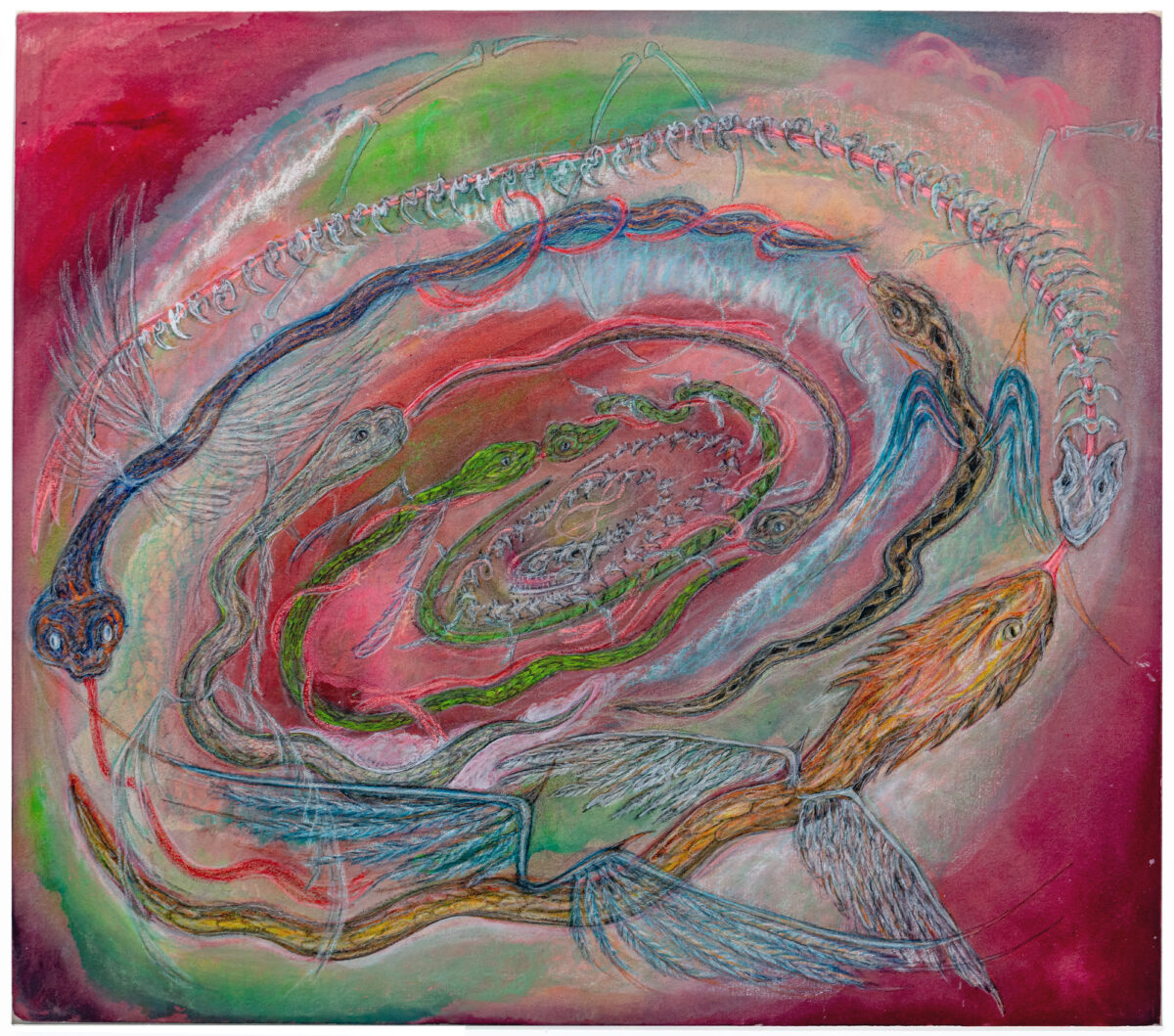
P.E.S.: How would you describe the inside energy of a painting? What does that energy mean to you in a painting?
C.H.A.: Energy is kinetic, kineticism is movement and movement makes change. Ultimately, the shift that happens within the structure of the painting reflects both the manual labor behind the creation and the psychological process of depicting an emotion.
As iconography transmits symbolic meaning, so color does emotion. There is a back and forth relationship between the perspective of the staining and the shapes of the background colors with the foreground shapes and lines.
The rational versus the irrational. Breaking apart the rationality of the iconographic or symbolic with the irrationality of abstraction or composition and finding a new space where they can exist to reflect the contemporary state of mind.
For this reason the immediacy of painting is important, as much as the forethought required for printmaking allows for structural integrity within otherwise chaotic intentions. My printmaking background is intrinsic to my painting practice.
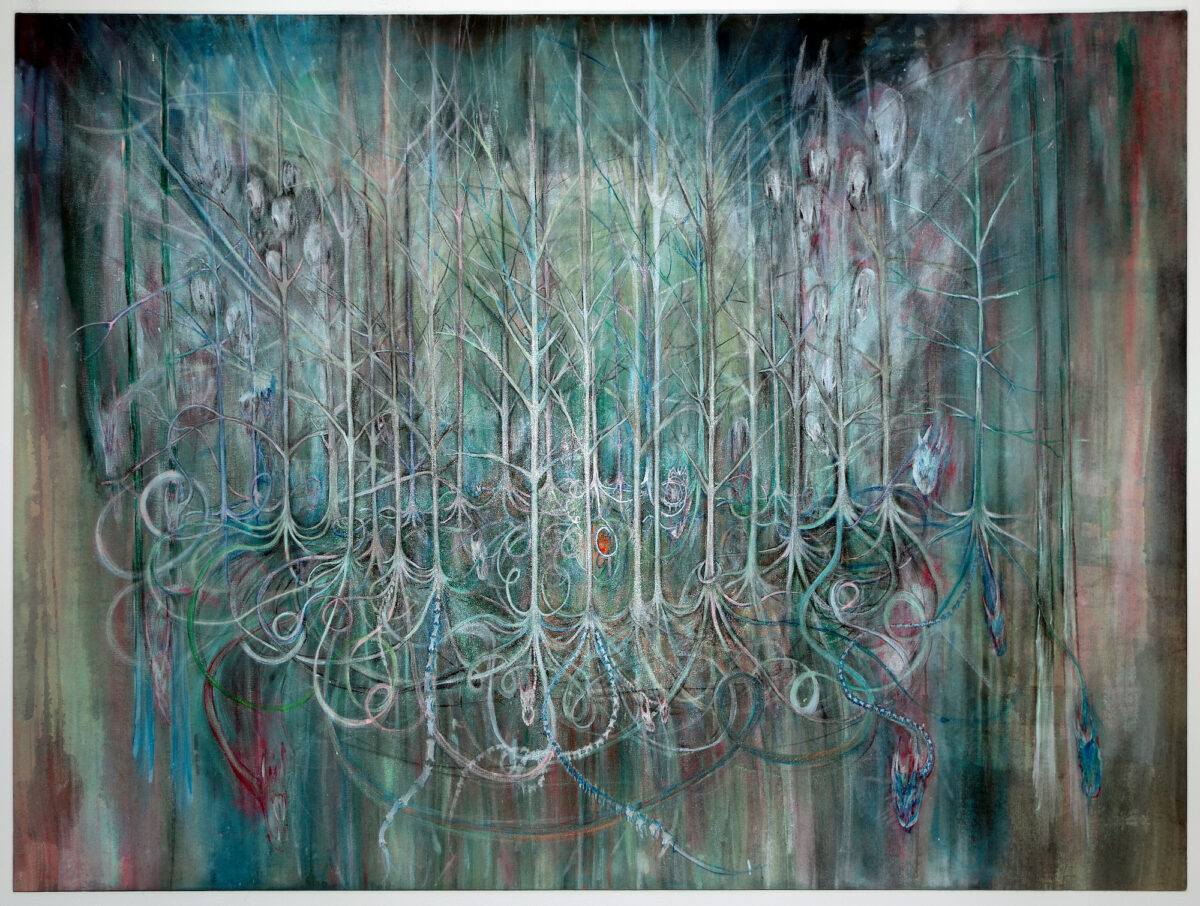
P.E.S.: As a person who is consistently engaged in research and discovery within the fields of globalization, mythologies, zooarchaeology, and trends within popular cultures in local and international cities, how do you view or define “communities,” and in what way do they inform or support your artwork?
C.H.A.: As a stubbornly independent person, I’d say community sort of happened to me, thankfully. It is the incredible people who over the years have been there for me, for each other, and continue to do so. Like, love, community on a sentimental level is what is left when you get rid of all the attachments you can explain and document.
Especially as we continue to evolve generationally, into having ever more options for who we can be, there is a need to anchor oneself somehow.
The murky waters of becoming revealed to me the infallible mooring it had been providing for many years. The places I had drifted to when I sort of rejected the embrace only highlighted this.
Community on an evidentiary level reflects a set of society and is defined by the location; date; and intentionality grouping these into something beyond a label but within a context. The disparate threads that make up the fabric of community highlight the meaningfulness of each individual factor: fraying threads or holes can lead the whole thing to begin to unravel and the way it was made will give the fabric a vastly different feel.

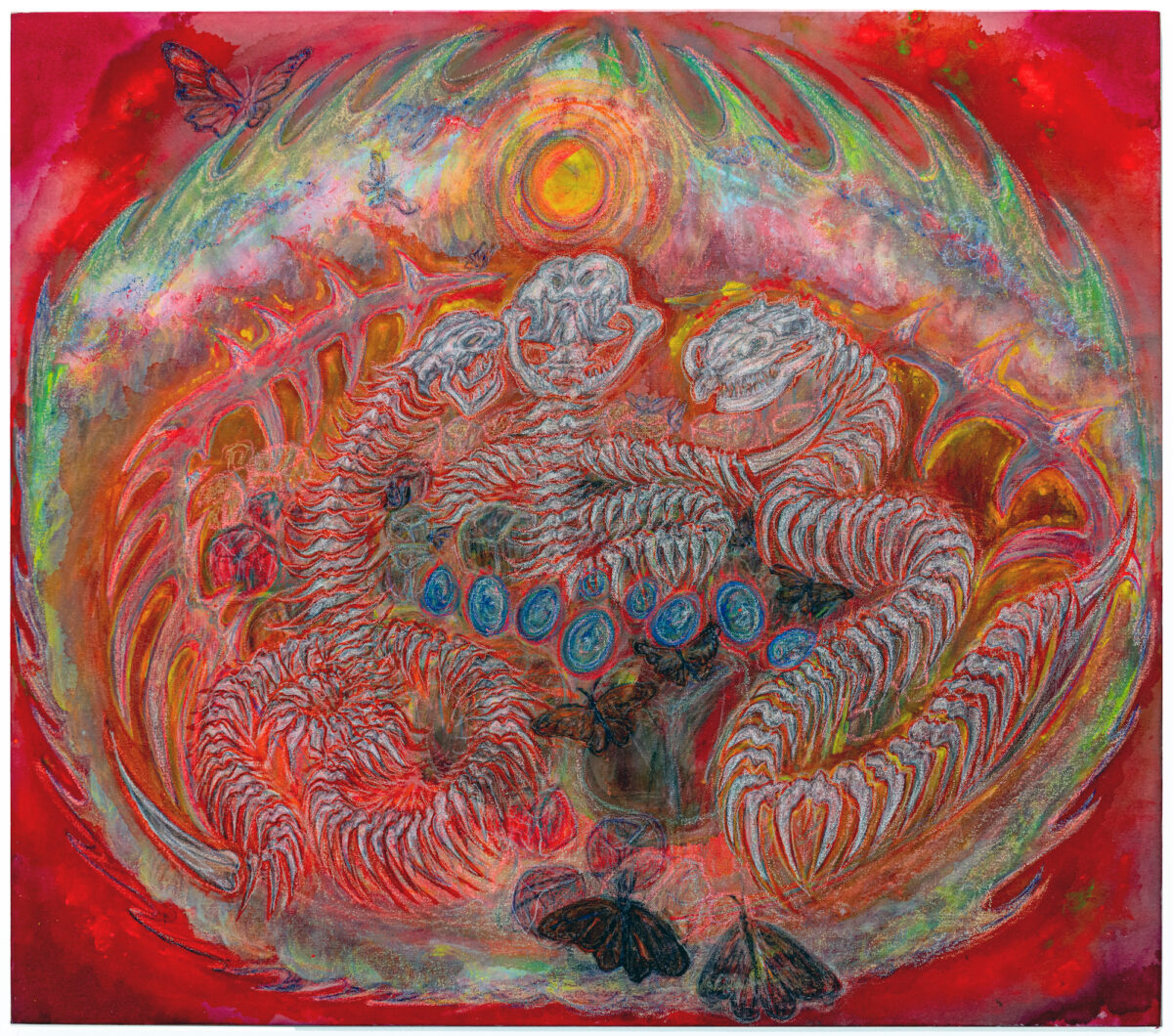
P.E.S.: You have recurring motifs in your paintings: certain animals and structures hold space. Can you give an example of a few that are your main focus at the moment, and do you foresee a future where you further embed your paintings with histories, relationships, and destinies?
C.H.A.: Structures are currently at the forefront of my mind. The things we build on, and are reduced to. What is always there, and what is not. Moving on from the social structure to the literal, I am referring to skeletons; branches; veins. Visually similar, metaphorically tied and symbolically relevant to the notion of perpetuity I look to indicate through the use of cyclical pattern and centered compositions.
My inability to communicate adequately verbally or emotionally as accurately as I would like. Alongside a general perpetual state of anxiety and morbid reflection of mortality. Allowing my visual language to adapt and grow with the awareness of affect by these factors is what I would like to focus on. For example, the loss of more rigid compositional and figurative elements in more recent work was a direct response to the elucidation that I did not really know where I was going, but I surely was certain of this fact alone.
It’s not about finding meaningfulness where there is none, but in finding meaning in the lack of it. Fully embracing my chaotic inner mind, and trying to make sense of shared anxieties and desperations critically. This finally brought me clarity and comfort.
Creatures and structures that exist within the scope of the fantastical in my paintings are the threads that bind them all together regardless of environmental shifts.
As to destiny- I wouldn’t presume to suppose any but the inevitability of meeting our own!
P.E.S.: I understand that your physical painterly process begins with the dyeing of your canvas; you have traditionally worked with raw linen, and you will build a color wash as your environmental background and build towards the foreground of the canvas. How do you navigate the dyeing process, and what do you look for in order to stop and further build upon your paintings?
C.H.A.: The beauty of emotionality!
The dyeing process begins fairly instinctively and develops intuitively, and through the process of doing it, I begin to know what kind of space I want to render- and how. Using the planes of color structurally, I will then build them up or down further. Often, I will use the colors from one piece to begin or add to another as a form of continuity between pieces.
Rendering background, foreground, light, shadow honors academic forms which were developed to strengthen representational quality. Applying them to my pieces has the same intention of communication, beyond the initial reactive stage of making.
I do have a codification of color and space in my work. Color schemes reflect recurrent geographical or metaphysical spaces, these are illustrated by recurrent compositions and motifs.
I have a tendency to overwork. Finding the right time to stop now means both trusting myself, and knowing myself. Once it has been built into a recognizable composition, the smaller details are both neurotic notes and an invitation to have a closer look.
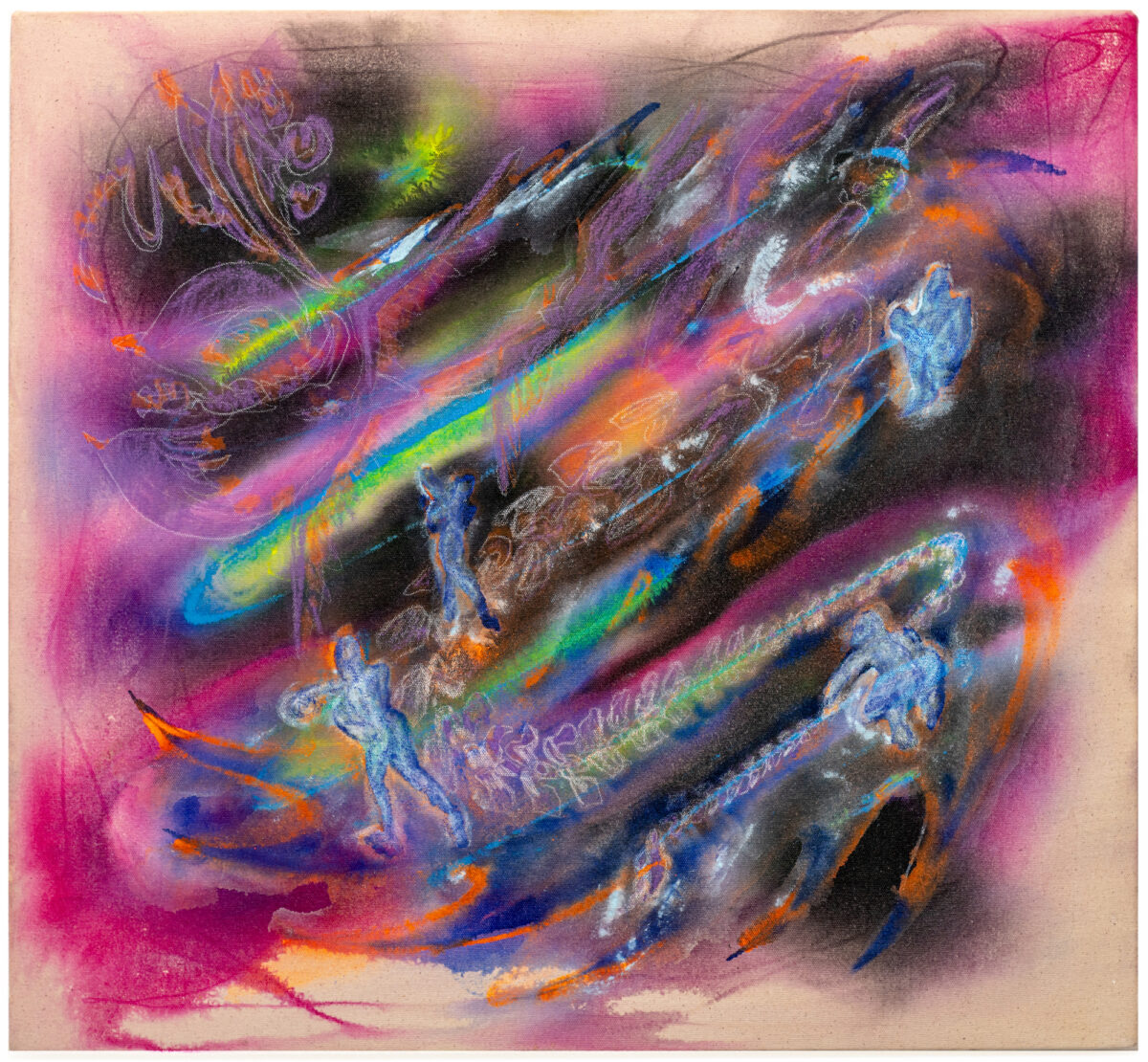
P.E.S.: Is there a single “Cecile Hirschler Alberti” universe that all your artistic production exists in, or are there multiple distinct worlds that separate them?
C.H.A.: These pieces are, indeed, “my little worlds”. I see them as pieces of myself or at least capsules of my neurosis, spun into, externalized through the simultaneously meditative and maddening medium of painting.
I name them according to various states of mind, thematically grouped under a religious or spiritual concept. Ritualistic labeling of the process behind which they were made. Maybe they will make up a whole Ceci universe some day. That would be very special. It would be to have known and mapped oneself almost entirely.
I do think we all create our little worlds, despite being connected through our existence on the one Earth. Particularly as we seek to escape the inevitable and damning truths of reality.

P.E.S.: It’s no surprise that your surrounding circumstances can affect your creative output. Do you think about “America” in your work?
C.H.A.: The USA is the country that gave my grandparents a safe home. It is also a country built on stolen land, by stolen people. The promise of immigration and new beginnings for some, while not satisfyingly concluding its own. These tensions are unmistakably present, as are the ensuing societal reverberations of general inequality.
New media art promised utopia through depiction, through recording, through statement and understanding. The quaintness of a slogan can seem incredibly powerful in a climate of unprecedented media oversaturation, or devastatingly subpar as a token of expression for the horrors of evolving modernity. When real-life documentary clips can be shared in seconds, recording performative commentary to convey the same can feel useless- to me, at least.
So yes- America features in my work. I don’t think I’d be looking for language so disjointed from reality if I liked what I was seeing. Disassociating into fantastic realms while engaging in violence within the fantasy is ultimately a coping mechanism, individually as an artist and collectively as a society.
I am currently participating in a group show titled, “I Think I’m in Trouble”, at SARA’s in Chinatown, referencing the theme of “pulling at the post-traumatic threads of modern surrealism”, which aptly reflects some of this sentiment.
P.E.S.: What are some scenarios you have been fabricating that you would like to share? What is next in terms of your worldbuilding?
C.H.A.: Boundaries were an important goal for myself this year. I want to extend this intentionality into my work, without losing the chaos.
An important focus for this is scale! Smaller pieces are postcards; larger pieces whole backdrops. I want to focus on the specificity of scale when exploring states of being and meaning. Larger canvasses and the scale of gestures they demand, alongside the commitment to their resolution as a whole, is something I’d like to do. An exciting opportunity to do so will be in my upcoming residency with Times Square Space. Within an office building overlooking Times Square, the space for scale and the wild energy of the historic destination is a literal iteration of controlled chaos.
See you there!
To learn more about Cecile Hirschler Alberti, follow her on Instagram at @catholic_ceviche and visit her website at cecilehirschleralberti.com





